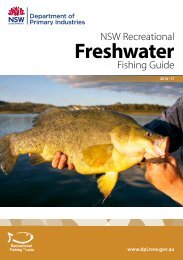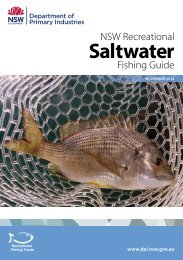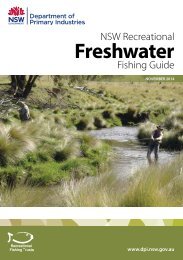freshwater-recreational-fishing-guide-2018-19
You also want an ePaper? Increase the reach of your titles
YUMPU automatically turns print PDFs into web optimized ePapers that Google loves.
55<br />
Conserving our biodiversity – aquatic habitats<br />
Conserving our biodiversity<br />
– aquatic habitats<br />
More habitat = more fish<br />
Healthy and diverse habitats mean healthy<br />
and diverse fish populations, a must if you<br />
want to catch fish. Habitats are those places<br />
where fish live, migrate to and from, feed and<br />
breed. Examples include rivers, billabongs,<br />
creeks and wetlands.<br />
Fish need to be able to access habitat.<br />
Too often fish are stopped by barriers such<br />
as poorly designed road crossings, weirs<br />
and dams.<br />
Fish habitat is also under pressure from<br />
expanding populations and some areas have<br />
been lost or degraded to the point where they<br />
no longer support native fish populations.<br />
NSW DPI is working with many people and<br />
organisations to protect and rehabilitate fish<br />
habitat to assist the recovery of fish stocks.<br />
Funding support from the <strong>recreational</strong><br />
<strong>fishing</strong> trusts has been provided to assist with<br />
this venture.<br />
■■<br />
Aquarium fish should stay in an aquarium.<br />
Never release them into a waterway or<br />
a drain.<br />
■■<br />
Get your friends or local <strong>fishing</strong> club involved<br />
in restoring fish habitat and check out the<br />
website www.fishhabitatnetwork.com.au<br />
NSW DPI also regulates activities that impact<br />
on key fish habitat. If you see or suspect any<br />
illegal activities affecting fish habitat contact<br />
your local NSW DPI fisheries office or the NSW<br />
DPI Fishers Watch Phoneline on 1800 043 536.<br />
Watch out for:<br />
■■<br />
Snags, native vegetation, sediment, gravel<br />
or cobble beds, rocks and rock bars being<br />
removed or damaged.<br />
■■<br />
Drains being dug or other works taking<br />
place in wetlands.<br />
■■<br />
Machinery working on the banks or<br />
within waterways.<br />
■■<br />
New bed or bank stabilisation works within<br />
a waterway.<br />
■■<br />
New waterfront structures such as jetties<br />
and boat ramps.<br />
■■<br />
Materials or fill being placed into a<br />
waterway e.g. tyres, concrete, sediment etc.<br />
■■<br />
Placing of permanent or temporary barriers<br />
to fish passage across a waterway e.g. new<br />
waterway crossings, nets, silt fences, fill.<br />
■■<br />
Discharge of pollutants into waterways.<br />
NSW Recreational Freshwater Fishing Guide<br />
Protecting biodiversity – tips to remember<br />
■■<br />
Travelling at low speed near riverbanks<br />
prevents your boat wake from<br />
undermining them.<br />
■■<br />
Snags are habitat for fish, not for use<br />
as firewood.<br />
■■<br />
Use established access points to launch and<br />
retrieve your boat or to access waterways<br />
by foot.<br />
■■<br />
Take all rubbish home or dispose<br />
appropriately, including <strong>fishing</strong> line<br />
and gear.<br />
■■<br />
Take care not to transport fish, water or<br />
weeds from one waterway to another. Wash<br />
down your boat, trailer and <strong>fishing</strong> gear to<br />
avoid spreading pests.<br />
See www.dpi.nsw.gov.au/<strong>fishing</strong>/habitat/<br />
rehabilitating/living-and-working-on-ariverbank<br />
for more information on works in<br />
waterways that require approval under the<br />
Fisheries Management Act <strong>19</strong>94.<br />
NSW DPI produces Newstreams, a<br />
free bi-monthly electronic newsletter<br />
to keep people up to date with aquatic<br />
habitat activities. To subscribe, email<br />
newstreams@dpi.nsw.gov.au and register<br />
your contact details.








